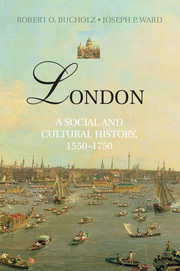Book contents
- Frontmatter
- Contents
- List of Illustrations and Maps
- List of Abbreviations and Conventions
- Acknowledgments
- Maps
- Introduction: London's Importance
- 1 London in 1550
- 2 The Socioeconomic Base
- 3 Royal and Civic London
- 4 Fine and Performed Arts
- 5 The Public Sphere and Popular Culture
- 6 The People on the Margins
- 7 Riot and Rebellion
- 8 Plague and Fire
- Conclusion: London in 1750
- Notes
- Further Reading
- Index
- Plate Section
1 - London in 1550
Published online by Cambridge University Press: 05 November 2012
- Frontmatter
- Contents
- List of Illustrations and Maps
- List of Abbreviations and Conventions
- Acknowledgments
- Maps
- Introduction: London's Importance
- 1 London in 1550
- 2 The Socioeconomic Base
- 3 Royal and Civic London
- 4 Fine and Performed Arts
- 5 The Public Sphere and Popular Culture
- 6 The People on the Margins
- 7 Riot and Rebellion
- 8 Plague and Fire
- Conclusion: London in 1750
- Notes
- Further Reading
- Index
- Plate Section
Summary
Our contemplation of London must begin, as London began, at the river. The River Thames is a slow-moving and rather murky body of water, flowing west to east, about a quarter to an eighth of a mile wide as it passes through the city. To this day, the sinewy thread of the Thames is London's most notable topographical feature, the curving line around which the metropolis orientates itself. As we have seen, this was not by chance. The Romans founded London in imitation of their own great capital city, so that, like Rome, London sits on its river at exactly the spot where it narrows enough to bridge (see Map 1). That confluence of west–east river and south–north bridge made London both a military choke point and an economic funnel long before our arrival sometime in 1550.
The Approach from the West and North
But in 1550, the river is not how most new Londoners come to town. Although it is possible to get there by boat, it is much more likely that we would arrive by land – on horseback if a gentleman or a wealthy merchant or their wives, on foot or on the back of a cart if a poor migrant looking for work – along dusty roads from all points of the compass. Perhaps the most spectacular land approach to London is the way Dick Whittington might have come from Gloucestershire, from the north and west, down the Great North Road through Hertfordshire to Finchley, down Hampstead Heath and Highgate Hill (both a hill and the road down it, although the latter was not laid out until 1386, a generation after Whittington's boyhood trek), to Islington, through the wall at Aldersgate into Aldersgate Street (see Map 2). If taking this route, we would naturally pause at the top of Highgate Hill, for this spot affords us our first glimpse of the great city. Looking south and slightly east, the first sight of England's capital would be astonishing to anyone from a tiny village. First, we spy the horizontal spectacle of the river, a silver-green snake undulating from horizon west to horizon east, dividing the city in two. On closer inspection, we realize that most of the city lies on our side of the river. Looking up across it to the smaller community of Southwark on the opposite or south bank, we see that the two are connected by London Bridge. The keen-eyed observer will make out houses and shops on the bridge and ships and barges in the river, reminding us that this is the commercial crossroads of the nation.
- Type
- Chapter
- Information
- LondonA Social and Cultural History, 1550–1750, pp. 33 - 63Publisher: Cambridge University PressPrint publication year: 2012

